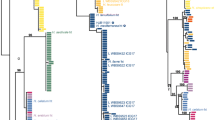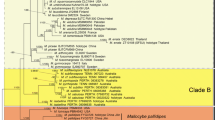Abstract
This paper addresses section Theobromina within the genus Hebeloma (Agaricales). We recognise seven European species within this section, three of which are described as new: Hebeloma alboerumpens, H. griseopruinatum and H. parvicystidiatum. The first two of these species appear to be ectomycorrhizal with Cistaceae: Cistus and Helianthemum. Hebeloma parvicystidiatum is more likely to be in mycorrhizal association with Quercus spp. We also provide a key to the European species within sect. Theobromina and an updated key of known Hebeloma associates of Cistus. Molecular analyses based on multiple loci further illustrate the distinctness of the newly described taxa and provide molecular evidence, supporting the morphological evidence, for the relationship that exists among species of this section. The ITS is the only one from the sequenced loci that, alongside with morphology, distinguishes among all of the species of sect. Theobromina. The section gains most of its molecular support from the MCM7 locus, followed by RPB2.




















Similar content being viewed by others
References
Aanen DK, Kuyper TW (1999) Intercompatibility tests in the Hebeloma crustuliniforme complex in northwestern Europe. Mycologia 91:783–795
Aanen DK, Kuyper TK, Boekhout T, Hoekstra RF (2000a) Phylogenetic relationships in the genus Hebeloma based on ITS1 and 2 sequences, with special emphasis on the Hebeloma crustuliniforme complex. Mycologia 92:269–281
Aanen DK, Kuyper TW, Mes THM, Hoekstra RF (2000b) The evolution of reproductive isolation in ectomycorrhizal Hebeloma crustuiniforme aggregate (basidiomycetes) in northwestern Europe: a phylogenetic approach. Evolution 54:1192–1206
Castresana J (2000) Selection of conserved blocks from multiple alignments for their use in phylogenetic analysis. Mol Biol Evol 17:540–552
Eberhardt U (2012) Methods for DNA barcoding fungi. In: Kress JW, Erickson DL (eds) DNA barcodes: methods and protocols. Humana Press, San Diego, pp 183–206. doi:10.1007/978-1-61779-591-6_9
Eberhardt U, Beker HJ (2010) Hebeloma vesterholtii, a new species in section Theobromina. Mycol Progress 9:215–223. doi:10.1007/s11557-009-0627-z
Eberhardt U, Beker HJ, Vila J, Vesterholt J, Llimona X, Gadjieva R (2009) Hebeloma species associated with Cistus. Mycol Res 113:153–162. doi:10.1016/j.mycres.2008.09.007
Flot J-F, Tillier A, Samadi S, Tillier S (2006) Phase determination from direct sequencing of length-variable DNA regions. Molecular Ecology Notes 6:627–630. doi:10.1111/j.1471-8286.2006.01355.x
Gardes M, Bruns TD (1993) ITS primers with enhanced specificity for basidiomycetes–application to the identification of mycorrhizae and rusts. Mol Ecol 2:113–118
Gonzalez P, Labarére J (1998) Sequence and secondary structure of the mitochondrial small-subunit rRNA V4, V6, and V9 domains reveal highly species-specific variations within the genus Agrocybe. Appl Environ Microbiol 64:4149–4160
Katoh K, Kuma K, Toh H, Miyata T (2005) MAFFT version 5: improvement in accuracy of multiple sequence alignment. Nucleic Acids Res 33:511–518. doi:10.1093/nar/gki198
Kauff F, Lutzoni F (2002) Phylogeny of the Gyalectales and Ostropales (Ascomycota, Fungi): among and within order relationships based on nuclear ribosomal RNA small and large subunits. Molecular Phylogenet Evol 25:138–156
Liu YL, Whelen S, Hall BD (1999) Phylogenetic relationships among ascomycetes: evidence from an RNA polymerase II subunit. Mol Biol Evol 16:1799–1808
Maddison WP, Maddison DR (2011) Mesquite: A modular system for evolutionary analysis. Version 2.75. http://mesquiteproject.org
Marmeisse R, Gryta H, Fraisinet-Tachet L, Gay G, Debaud JC (1999) Hebeloma. In: Cairney JWG, Chambers SM (eds) Ectomycorrhizal Fungi - Key Genera in Profile. Springer, Berlin, pp 89–127
Matheny PB (2005) Improving phylogenetic inference of mushrooms with RPB1 and RPB2 nucleotide sequences (Inocybe, Agaricales). Molecular Phylogenet Evol 35:1–20. doi:10.1016/j.ympev.2004.11.014
Miller MA, Pfeiffer W, Schwartz T (2010) Creating the CIPRES Science Gateway for inference of large phylogenetic trees. In: Proceedings of the Gateway Computing Environments Workshop (GCE), 14 Nov. 2010, New Orleans, LA pp 1 - 8. doi:10.1109/GCE.2010.5676129
Moser M (1985) Beiträge zur Kenntnis der Gattung Hebeloma. II. Sydowia 38:171–177
Mouhamadou B, Carriconde F, Gryta H, Jargeat P, Manzi S, Gardes M (2008) Molecular evolution of mitochondrial ribosomal DNA in the fungal genus Tricholoma: barcoding implications. Fungal Genet Biol 45:1219–1226. doi:10.1016/j.fgb.2008.06.006
Ortega A, Esteve-Raventόs F (1999) Estudios sobre el género Hebeloma en España Peninsular. III. Un estudio comparativo entre H. truncatum, H truncatum var. pruinosum y H. erumpens. Micol Veg Mediterranea 14:151–158
Quadraccia L (1987) Recherches sur Hebeloma (Agaricales, Cortinariaceae). I Quelques Notes Taxonomiques et nomenclaturales. Mycotaxon 30:301–318
Raja HA, Schoch CL, Hustad VP, Shearer CA, Miller AN (2011) Testing the phylogenetic utility of MCM7 in the Ascomycota. MycoKeys 1:63–94. doi:10.3897/mycokeys.1.1966
Rambaut A (2002) Se-Al. Sequence alignment editor version 2.0a11, Department of Zoology, University of Oxford. http://tree.bio.ed.ac.uk/software/seal/
Rambaut A (2009) Tree figure drawing tool version 1.3.1. Institute of Evolutionary Biology, University of Edinburgh. http://tree.bio.ed.ac.uk/
Rehner SA, Samuels GJ (1994) Taxonomy and phylogeny of Gliocladium analysed from nuclear large subunit ribosomal DNA sequences. Mycol Res 98:625–634
Schmitt I, Crespo A, Divakar PK, Fankhauser JD, Herman-Sackett E, Kalb K, Nelsen MP, Nelson NA, Rivas-Plata E, Shimp AD, Widhelm T, Lumbsch HT (2009) New primers for promising single-copy genes in fungal phylogenetics and systematics. Persoonia 23:35–40. doi:10.3767/003158509X470602
Schoch CL, Seifert KA, Huhndorf S, Robert V, Spouge JL, Levesque CA, Chen W, Fungal Barcoding Consortium (2012) Nuclear ribosomal internal transcribed spacer (ITS) region as a universal DNA barcode marker for Fungi. PNAS 109:6241–6246. doi:10.1073/pnas.1117018109
Stamatakis A (2006) RAxML-VI-HPC: maximum likelihood-based phylogenetic analyses with thousands of taxa and mixed models. Bioinformatics Applications Note 22:2688–2690. doi:10.1093/bioinformatics/btl446
Stamatakis A, Hoover P, Rougemont J (2008) A rapid bootstrap algorithm for the RAxML web servers. Syst Biol 57:758–771. doi:10.1080/10635150802429642
Talavera G, Castresana J (2007) Improvement of phylogenies after removing divergent and ambiguously aligned blocks from protein sequence alignments. Syst Biol 56:564–577. doi:10.1080/10635150701477825
Taylor AFS, Hills A, Simonini G, Both EE, Eberhardt U (2006) Detection of species within the Xerocomus subtomentosus complex in Europe using rDNA-ITS sequences. Mycol Res 110:276–287. doi:10.1016/j.mycres.2005.11.013
Taylor AFS, Hills A, Simonini G, Muñoz JA, Eberhardt U (2007) Xerocomus silwoodensis sp. nov., a new species within the European X. subtomentosus complex. Mycol Res 111:403–408. doi:10.1016/j.mycres.2007.01.014
Vesterholt J (2004) The identity of Hebeloma fastibile, the type species of Hebeloma. Annali Micol AGMT 1:53–63
Vesterholt J (2005) The Genus Hebeloma. [Fungi of Northern Europe Volume 3] Danish Mycological Society, Copenhagen
Vilgalys R, Hester M (1990) Rapid genetic identification and mapping of enzymatically amplified ribosomal DNA from several species of Cryptococus. J Bacteriol 172:4238–4246
White TJ, Bruns TD, Lee S, Taylor JW (1990) Amplification and direct sequencing of fungal ribosomal RNA genes for phylogenetics. In: Innis MA, Gelfand H, Sninsky JS, White TJ (eds) PCR protocols: a guide to methods and applications. Academic, San Diego, pp 315–322
Acknowledgements
The authors would like to thank the herbaria in C (Copenhagen), CAG (Cagliari), IB (Innsbruck), H (Helsinki), ROHB (Rome) and TUR (Turku) for the loan of collections for study and sequencing, BR (Meise) for kindly handling the loans and to P.-A. Moreau from LIP (Lille) for managing the deposits. Furthermore, we very much appreciated the help of M. Contu, L. Contu, G. Corriol, D. Ghyselinck, A. Hausknecht, J. Heilmann-Clausen, A. Henrici, C. Hobart, H. Knudsen, K. Kokkonen, L. Krieglsteiner, I. Kytovuori, A. Lesonen, X. Llimona, M. Moser, L. Quadraccia, F. Reinwald, S. Scoles, K. Soop, J. Vauras for supplying us with interesting and exciting Hebeloma collections. Thanks also go to R. Foster, C. Hobart and C. Lovatt who regularly visited Bincliffe Mines in the UK for the past several years searching for H. griseopruinatum, although it failed to put in an appearance during any of their visits. We would also like to thank D. Öncü, C. Lundström, J. Petterson, M. Jonsson and R. Gadjieva for their assistance in the lab. The molecular data provided by J. Vila was funded by the project ‘Biodiversitat de fongs i líquens dels Països Catalans’ from the Secció de Ciències of Institut d’Estudis Catalans.
Author information
Authors and Affiliations
Corresponding author
Additional information
Deceased: Jan Vesterholt
Rights and permissions
About this article
Cite this article
Eberhardt, U., Beker, H.J., Vesterholt, J. et al. European Species of Hebeloma Section Theobromina . Fungal Diversity 58, 103–126 (2013). https://doi.org/10.1007/s13225-012-0188-3
Received:
Accepted:
Published:
Issue Date:
DOI: https://doi.org/10.1007/s13225-012-0188-3




